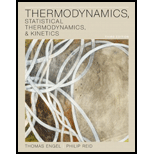
(a)
Interpretation: The value of change in entropy, change in total entropy and change in entropy of surrounding for an adiabatic reversible expansion needs to be calculated. Whether the process is spontaneous or not needs to be determined.
Concept Introduction:
The change in entropy can be calculated as follows:
Here,
(b)
Interpretation: The value of change in entropy, change in total entropy and change in entropy of surrounding for an expansion against external pressure equal to zero needs to be determined. Whether the process is spontaneous or not needs to be determined.
Concept Introduction: The change in entropy for an adiabatic expansion can be calculated as follows:
Here,
(c)
Interpretation: The value of change in entropy, change in total entropy and change in entropy of surrounding for an isothermal reversible expansion needs to be determined. Whether the process is spontaneous or not needs to be determined.
Concept Introduction: The change in entropy for can be calculated as follows:
Here,
Want to see the full answer?
Check out a sample textbook solution
Chapter 5 Solutions
Thermodynamics, Statistical Thermodynamics, & Kinetics
- What is the finaltemperature of0.122 mole ofmonatomic ideal gas that performs 75J of work adiabatically if the initial temperature is 235C?arrow_forward1.4 g of N2 are placed in a cylinder at an initial volume of 3.8 L and allowed to expand isothermally to a final volume of 10.8 liters against a constant external pressure of 0.8 bar. (A) Treating N2 as a perfect gas, find q, w, ΔU, ΔH, and ΔS for this process. (B) Now assume that the same process occurs, but that N2 can be assumed to have attractive forces between the molecules. In this case, how would q differ from the answer given in (A)? Specifically, would the value be larger, smaller, or unchanged? Explain your answer in 10 words or less. Can you please explain part a and b? <reference> Ne has a mass of 20.18 amu, N2 has a mass of 28.01 amu, H2 has a mass of 1.01 amu, Ar has a mass of 39.95 amu, and He has a mass of 4.00 amu.arrow_forwardCalculate q, w, ΔH and ΔU for the reversible isothermal expansion of one mole of anideal gas at 270C from a volume of 10 dm3 to a volume of 20 dm3, against a constantexternal pressure of 1 atm.arrow_forward
- Assume N₂ behaves as perfect gas. It expands reversibly and adiabatically from Vi to Vf with the pressure change from pi to pf. (a) Derive the temperature versus volume relationship and the pressure and volume relationship for this expansion. (b) When a sample of N₂ of mass 3.12 g at 23.0 °C is allowed to expand reversibly and adiabatically from 4.00 × 10² cm3 to 2.00 dm3, what is the work done by the gas?arrow_forwardCalculate the total change in entropy, when a sample of nitrogen gas of mass 28 g at 298 K and 1.00 bar doubles its volume in (a) an isothermal reversible expansion, b) an isothermal irreversible expansion against paxt = 0, (c) an adiabatic reversible expansion.arrow_forward(a) Calculate ∆S when the state of a weather balloon filled with 3.00 mol He gas molecules is changed from 50 ⁰C and 2.00 atm to 75 ⁰C and 4.00 atm. (b) 1 mol He gas sample that is initially at 10 °C, undergoes reversible adiabatic expansion from 200 cm3 tot 1.00 dm3. Calculate the final temperature of the sample.arrow_forward
- One mole (1.0 mol) of an ideal gas is initially at T1 = 298 K and has volume V1 = 2.0 L. It is then reversibly expanded to final volume V2 = 3.0 L. Assume Cp = 5/2 R and Cv = 3/2R. a) Calculate the following if the expansion is isothermal: 1) ΔT 2) q 3) w 4) ΔU 5) ΔH b) Calculate ΔT–ΔU if the expansion is adiabatic instead of isothermal.c) Calculate the initial pressure and two final pressures for the process in a) & b).d) On a single set of axes, sketch a pressure–volume plot for each of the two processes in a) & b). Label the area that corresponds to the work for each process.arrow_forward(c) Teacher explained the process of heat capacity, work done and first law of thermodynamics and asked students to use the previous knowledge of ideal gasses and relate it with the present topic. He asked them to solve the following question. An ideal gas of 2.5 moles at 25 °C and 125 x 103 Pa, for which Cv,m= 3/2R, is expanded isothermally against a constant pressure of 15.2 x 103 Pa to twice the initial volume. Calculate q, w, and AU?arrow_forward2. (a) A sample consisting of 1.00mol Ar is expanded isothermally at 20 °C from 10.0dm3 to 30.0dm3 (i) reversibly, (ii) against a constant external pressure equal to the final pressure of the gas, and (iii) freely (against zero external pressure). For the three processes calculate q, w, and ΔU.arrow_forward
 Chemistry & Chemical ReactivityChemistryISBN:9781133949640Author:John C. Kotz, Paul M. Treichel, John Townsend, David TreichelPublisher:Cengage Learning
Chemistry & Chemical ReactivityChemistryISBN:9781133949640Author:John C. Kotz, Paul M. Treichel, John Townsend, David TreichelPublisher:Cengage Learning Physical ChemistryChemistryISBN:9781133958437Author:Ball, David W. (david Warren), BAER, TomasPublisher:Wadsworth Cengage Learning,
Physical ChemistryChemistryISBN:9781133958437Author:Ball, David W. (david Warren), BAER, TomasPublisher:Wadsworth Cengage Learning, Chemistry: Principles and PracticeChemistryISBN:9780534420123Author:Daniel L. Reger, Scott R. Goode, David W. Ball, Edward MercerPublisher:Cengage Learning
Chemistry: Principles and PracticeChemistryISBN:9780534420123Author:Daniel L. Reger, Scott R. Goode, David W. Ball, Edward MercerPublisher:Cengage Learning Principles of Modern ChemistryChemistryISBN:9781305079113Author:David W. Oxtoby, H. Pat Gillis, Laurie J. ButlerPublisher:Cengage Learning
Principles of Modern ChemistryChemistryISBN:9781305079113Author:David W. Oxtoby, H. Pat Gillis, Laurie J. ButlerPublisher:Cengage Learning Chemistry: The Molecular ScienceChemistryISBN:9781285199047Author:John W. Moore, Conrad L. StanitskiPublisher:Cengage Learning
Chemistry: The Molecular ScienceChemistryISBN:9781285199047Author:John W. Moore, Conrad L. StanitskiPublisher:Cengage Learning Chemistry for Engineering StudentsChemistryISBN:9781337398909Author:Lawrence S. Brown, Tom HolmePublisher:Cengage Learning
Chemistry for Engineering StudentsChemistryISBN:9781337398909Author:Lawrence S. Brown, Tom HolmePublisher:Cengage Learning





